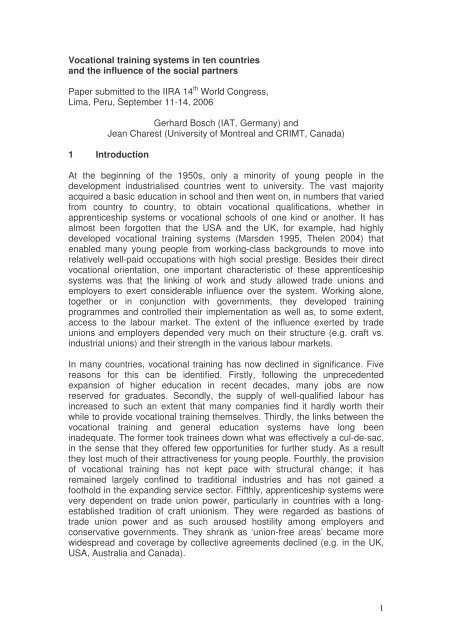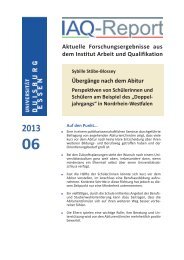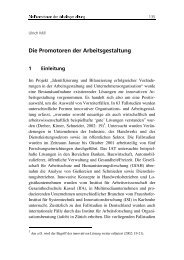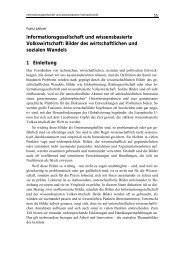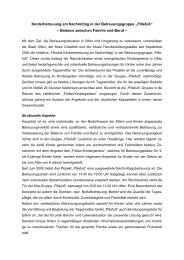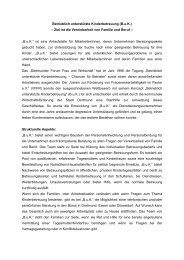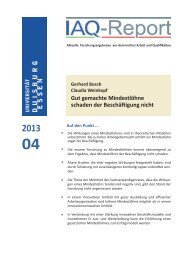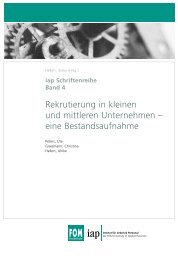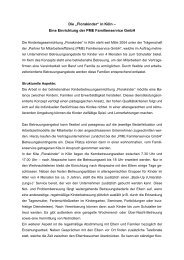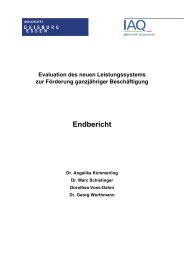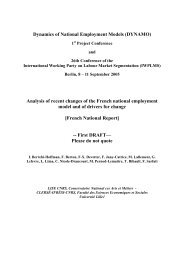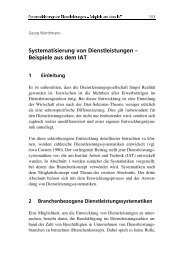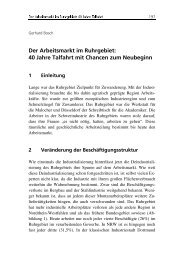1 Vocational training systems in ten countries and the influence of ...
1 Vocational training systems in ten countries and the influence of ...
1 Vocational training systems in ten countries and the influence of ...
Create successful ePaper yourself
Turn your PDF publications into a flip-book with our unique Google optimized e-Paper software.
<strong>Vocational</strong> <strong>tra<strong>in</strong><strong>in</strong>g</strong> <strong>systems</strong> <strong>in</strong> <strong>ten</strong> <strong>countries</strong><br />
<strong>and</strong> <strong>the</strong> <strong>in</strong>fluence <strong>of</strong> <strong>the</strong> social partners<br />
Paper submitted to <strong>the</strong> IIRA 14 th World Congress,<br />
Lima, Peru, September 11-14, 2006<br />
Gerhard Bosch (IAT, Germany) <strong>and</strong><br />
Jean Charest (University <strong>of</strong> Montreal <strong>and</strong> CRIMT, Canada)<br />
1 Introduction<br />
At <strong>the</strong> beg<strong>in</strong>n<strong>in</strong>g <strong>of</strong> <strong>the</strong> 1950s, only a m<strong>in</strong>ority <strong>of</strong> young people <strong>in</strong> <strong>the</strong><br />
development <strong>in</strong>dustrialised <strong>countries</strong> went to university. The vast majority<br />
acquired a basic education <strong>in</strong> school <strong>and</strong> <strong>the</strong>n went on, <strong>in</strong> numbers that varied<br />
from country to country, to obta<strong>in</strong> vocational qualifications, whe<strong>the</strong>r <strong>in</strong><br />
apprenticeship <strong>systems</strong> or vocational schools <strong>of</strong> one k<strong>in</strong>d or ano<strong>the</strong>r. It has<br />
almost been forgot<strong>ten</strong> that <strong>the</strong> USA <strong>and</strong> <strong>the</strong> UK, for example, had highly<br />
developed vocational <strong>tra<strong>in</strong><strong>in</strong>g</strong> <strong>systems</strong> (Marsden 1995, Thelen 2004) that<br />
enabled many young people from work<strong>in</strong>g-class backgrounds to move <strong>in</strong>to<br />
relatively well-paid occupations with high social prestige. Besides <strong>the</strong>ir direct<br />
vocational orientation, one important characteristic <strong>of</strong> <strong>the</strong>se apprenticeship<br />
<strong>systems</strong> was that <strong>the</strong> l<strong>in</strong>k<strong>in</strong>g <strong>of</strong> work <strong>and</strong> study allowed trade unions <strong>and</strong><br />
employers to exert considerable <strong>in</strong>fluence over <strong>the</strong> system. Work<strong>in</strong>g alone,<br />
toge<strong>the</strong>r or <strong>in</strong> conjunction with governments, <strong>the</strong>y developed <strong>tra<strong>in</strong><strong>in</strong>g</strong><br />
programmes <strong>and</strong> controlled <strong>the</strong>ir implementation as well as, to some ex<strong>ten</strong>t,<br />
access to <strong>the</strong> labour market. The ex<strong>ten</strong>t <strong>of</strong> <strong>the</strong> <strong>in</strong>fluence exerted by trade<br />
unions <strong>and</strong> employers depended very much on <strong>the</strong>ir structure (e.g. craft vs.<br />
<strong>in</strong>dustrial unions) <strong>and</strong> <strong>the</strong>ir strength <strong>in</strong> <strong>the</strong> various labour markets.<br />
In many <strong>countries</strong>, vocational <strong>tra<strong>in</strong><strong>in</strong>g</strong> has now decl<strong>in</strong>ed <strong>in</strong> significance. Five<br />
reasons for this can be identified. Firstly, follow<strong>in</strong>g <strong>the</strong> unprecedented<br />
expansion <strong>of</strong> higher education <strong>in</strong> recent decades, many jobs are now<br />
reserved for graduates. Secondly, <strong>the</strong> supply <strong>of</strong> well-qualified labour has<br />
<strong>in</strong>creased to such an ex<strong>ten</strong>t that many companies f<strong>in</strong>d it hardly worth <strong>the</strong>ir<br />
while to provide vocational <strong>tra<strong>in</strong><strong>in</strong>g</strong> <strong>the</strong>mselves. Thirdly, <strong>the</strong> l<strong>in</strong>ks between <strong>the</strong><br />
vocational <strong>tra<strong>in</strong><strong>in</strong>g</strong> <strong>and</strong> general education <strong>systems</strong> have long been<br />
<strong>in</strong>adequate. The former took tra<strong>in</strong>ees down what was effectively a cul-de-sac,<br />
<strong>in</strong> <strong>the</strong> sense that <strong>the</strong>y <strong>of</strong>fered few opportunities for fur<strong>the</strong>r study. As a result<br />
<strong>the</strong>y lost much <strong>of</strong> <strong>the</strong>ir attractiveness for young people. Fourthly, <strong>the</strong> provision<br />
<strong>of</strong> vocational <strong>tra<strong>in</strong><strong>in</strong>g</strong> has not kept pace with structural change; it has<br />
rema<strong>in</strong>ed largely conf<strong>in</strong>ed to traditional <strong>in</strong>dustries <strong>and</strong> has not ga<strong>in</strong>ed a<br />
foothold <strong>in</strong> <strong>the</strong> exp<strong>and</strong><strong>in</strong>g service sector. Fifthly, apprenticeship <strong>systems</strong> were<br />
very dependent on trade union power, particularly <strong>in</strong> <strong>countries</strong> with a longestablished<br />
tradition <strong>of</strong> craft unionism. They were regarded as bastions <strong>of</strong><br />
trade union power <strong>and</strong> as such aroused hostility among employers <strong>and</strong><br />
conservative governments. They shrank as ‘union-free areas’ became more<br />
widespread <strong>and</strong> coverage by collective agreements decl<strong>in</strong>ed (e.g. <strong>in</strong> <strong>the</strong> UK,<br />
USA, Australia <strong>and</strong> Canada).<br />
1
Only <strong>in</strong> <strong>countries</strong> with strong trade unions <strong>and</strong> a tradition <strong>of</strong> corporatist<br />
cooperation (Germany, Austria, Switzerl<strong>and</strong> <strong>and</strong>, <strong>in</strong> some respects, Denmark<br />
<strong>and</strong> Norway) have new apprenticeship programmes been successfully<br />
established <strong>in</strong> manufactur<strong>in</strong>g <strong>in</strong>dustry as well as <strong>in</strong> <strong>the</strong> service sector. These<br />
<strong>countries</strong> have not seen <strong>the</strong>ir vocational <strong>tra<strong>in</strong><strong>in</strong>g</strong> <strong>systems</strong> decl<strong>in</strong>e <strong>in</strong><br />
significance to <strong>the</strong> same ex<strong>ten</strong>t <strong>and</strong>, from an <strong>in</strong>ternational perspective, seem<br />
almost like exotic blooms. This is all <strong>the</strong> more true s<strong>in</strong>ce not only highly<br />
developed <strong>countries</strong> but also upcom<strong>in</strong>g former develop<strong>in</strong>g <strong>countries</strong> <strong>and</strong><br />
Central <strong>and</strong> Eastern European <strong>countries</strong> have adopted development<br />
strategies based largely on general secondary <strong>and</strong> tertiary education. In many<br />
cases, <strong>the</strong> weakness <strong>of</strong> <strong>the</strong>ir employers’ associations <strong>and</strong> trade unions leave<br />
<strong>the</strong>m with little choice but to rely on statist strategies.<br />
The consequences <strong>of</strong> <strong>the</strong> decl<strong>in</strong>e <strong>of</strong> vocational <strong>tra<strong>in</strong><strong>in</strong>g</strong> <strong>systems</strong> are now<br />
evident. Companies <strong>in</strong> many <strong>countries</strong> are compla<strong>in</strong><strong>in</strong>g <strong>of</strong> a shortage <strong>of</strong><br />
vocationally qualified labour. What is miss<strong>in</strong>g, between a grow<strong>in</strong>g share <strong>of</strong><br />
university graduates with <strong>the</strong>ir largely <strong>the</strong>oretical <strong>tra<strong>in</strong><strong>in</strong>g</strong> <strong>and</strong> a high share <strong>of</strong><br />
workers without any <strong>tra<strong>in</strong><strong>in</strong>g</strong>, is <strong>the</strong> <strong>in</strong>termediate tier <strong>of</strong> tra<strong>in</strong>ed workers with<br />
both practical <strong>and</strong> <strong>the</strong>oretical skills. In some <strong>in</strong>stances, classic craft unionism<br />
has shifted up a level <strong>and</strong> now occurs <strong>in</strong> new forms – sometimes <strong>in</strong> craft<br />
unions, sometimes <strong>in</strong> pr<strong>of</strong>essional lobby organisations – among <strong>the</strong> liberal<br />
pr<strong>of</strong>essions, such as doctors, teachers <strong>and</strong> eng<strong>in</strong>eers. Many governments are<br />
try<strong>in</strong>g to raise <strong>the</strong> status <strong>of</strong> vocational <strong>tra<strong>in</strong><strong>in</strong>g</strong>. New apprenticeship <strong>systems</strong><br />
are be<strong>in</strong>g established, school-based vocational <strong>tra<strong>in</strong><strong>in</strong>g</strong> is be<strong>in</strong>g exp<strong>and</strong>ed<br />
<strong>and</strong>, <strong>in</strong> those <strong>countries</strong> with weak vocational <strong>tra<strong>in</strong><strong>in</strong>g</strong> <strong>systems</strong>, <strong>the</strong> universities<br />
are react<strong>in</strong>g to firms’ needs by <strong>in</strong>creas<strong>in</strong>g <strong>the</strong>ir provision <strong>of</strong> courses with a<br />
strong vocational con<strong>ten</strong>t.<br />
It is unclear whe<strong>the</strong>r <strong>the</strong>re will be a renaissance <strong>of</strong> vocational <strong>tra<strong>in</strong><strong>in</strong>g</strong> or<br />
whe<strong>the</strong>r this is actually possible without <strong>the</strong> social partners play<strong>in</strong>g a strong<br />
role. This is <strong>the</strong> question we <strong>in</strong><strong>ten</strong>d to <strong>in</strong>vestigate <strong>in</strong> this paper. We suspect<br />
that <strong>the</strong> broad-brush typologies developed <strong>in</strong> <strong>the</strong> 1980s <strong>and</strong> 90s are no longer<br />
capable <strong>of</strong> adequately describ<strong>in</strong>g current developments. Our analysis is<br />
based on <strong>the</strong> <strong>in</strong>itial results <strong>of</strong> a research project <strong>in</strong> which <strong>the</strong> vocational<br />
<strong>tra<strong>in</strong><strong>in</strong>g</strong> <strong>systems</strong> <strong>in</strong> 10 <strong>countries</strong> (D, DK, F, USA, UK, Can, Aus, Morocco,<br />
South Korea <strong>and</strong> Mexico) were compared with each o<strong>the</strong>r 1 . In this paper, we<br />
will exam<strong>in</strong>e developments <strong>in</strong> only some <strong>of</strong> <strong>the</strong>se groups <strong>of</strong> <strong>countries</strong>. We<br />
beg<strong>in</strong> by look<strong>in</strong>g at two <strong>countries</strong> with modernised apprenticeship <strong>systems</strong> (D,<br />
DK) (section 2). We <strong>the</strong>n turn our at<strong>ten</strong>tion to two Anglo-Saxon <strong>countries</strong><br />
(section 3). In section 4, we analyse one <strong>of</strong> <strong>the</strong> up-<strong>and</strong>-com<strong>in</strong>g <strong>in</strong>dustrialised<br />
<strong>countries</strong>, namely South Korea.<br />
2. The dual system <strong>of</strong> vocational <strong>tra<strong>in</strong><strong>in</strong>g</strong> <strong>in</strong> Germany <strong>and</strong> Denmark<br />
In Denmark, approximately one third <strong>of</strong> school-leavers go <strong>in</strong>to <strong>the</strong> dual system<br />
<strong>of</strong> vocational <strong>tra<strong>in</strong><strong>in</strong>g</strong>. In Germany, almost two thirds opt for vocational <strong>tra<strong>in</strong><strong>in</strong>g</strong><br />
<strong>of</strong> some k<strong>in</strong>d; <strong>of</strong> <strong>the</strong>se, three quarters go <strong>in</strong>to <strong>the</strong> dual system <strong>and</strong> one quarter<br />
<strong>in</strong>to school-based <strong>tra<strong>in</strong><strong>in</strong>g</strong>. There are strong similarities between <strong>the</strong> two<br />
1 The project is supported by <strong>the</strong> Alex<strong>and</strong>er von Humboldt Foundation <strong>and</strong> by CRIMT.<br />
2
<strong>countries</strong>’ vocational <strong>tra<strong>in</strong><strong>in</strong>g</strong> <strong>systems</strong>, as well as some significant differences.<br />
Both <strong>countries</strong> base <strong>the</strong>ir system on <strong>the</strong> notion <strong>of</strong> occupation. The end goal <strong>of</strong><br />
<strong>the</strong> <strong>tra<strong>in</strong><strong>in</strong>g</strong> process is compe<strong>ten</strong>cy <strong>in</strong> a broadly def<strong>in</strong>ed occupational area;<br />
this compe<strong>ten</strong>cy is acquired <strong>in</strong> <strong>the</strong> course <strong>of</strong> a three to four-year course <strong>of</strong><br />
<strong>tra<strong>in</strong><strong>in</strong>g</strong>. The <strong>tra<strong>in</strong><strong>in</strong>g</strong> process is not divided up <strong>in</strong>to <strong>in</strong>dividual modules, s<strong>in</strong>ce<br />
this would compromise <strong>the</strong> broad occupational base <strong>of</strong> <strong>the</strong> <strong>tra<strong>in</strong><strong>in</strong>g</strong> <strong>and</strong> its<br />
recognition <strong>in</strong> <strong>the</strong> labour market. Admission to a vocational <strong>tra<strong>in</strong><strong>in</strong>g</strong><br />
programme is dependent on <strong>the</strong> conclusion <strong>of</strong> a <strong>tra<strong>in</strong><strong>in</strong>g</strong> contract with a<br />
company. Learn<strong>in</strong>g <strong>in</strong> <strong>the</strong> workplace is comb<strong>in</strong>ed with <strong>the</strong>oretical study <strong>in</strong><br />
vocational schools.<br />
In both <strong>countries</strong>, <strong>the</strong> dual system has kept pace with structural change. New<br />
service occupations have been def<strong>in</strong>ed <strong>and</strong> <strong>the</strong> old occupational pr<strong>of</strong>iles have<br />
been modernised, ma<strong>in</strong>ly by merg<strong>in</strong>g related, highly specialised occupations.<br />
In Germany, for example, 45 metalwork<strong>in</strong>g occupations were reduced to 16 <strong>in</strong><br />
1987 <strong>and</strong> <strong>the</strong>n, <strong>in</strong> 2005, <strong>the</strong>se 16 occupations were merged to form 5 basic<br />
occupations. Teach<strong>in</strong>g methods have changed considerably <strong>in</strong> recent years <strong>in</strong><br />
response to changes <strong>in</strong> work organisation (Bosch 2000). In <strong>the</strong> past, work<br />
organisation <strong>systems</strong> were based on a functional <strong>and</strong> hierarchical division <strong>of</strong><br />
labour. These <strong>systems</strong> were mirrored <strong>in</strong> <strong>the</strong> subject-based <strong>tra<strong>in</strong><strong>in</strong>g</strong> curricula.<br />
In modern work organisation <strong>systems</strong>, <strong>the</strong> various occupations, work<strong>in</strong>g <strong>in</strong><br />
teams, coord<strong>in</strong>ate <strong>the</strong>ir activities on a decentralised basis. Thus <strong>the</strong> <strong>tra<strong>in</strong><strong>in</strong>g</strong><br />
model that prevails today is based on work <strong>in</strong> teams to which responsibility<br />
has been devolved. Consequently, <strong>the</strong> focus is on team-based learn<strong>in</strong>g <strong>and</strong><br />
project work; this also enables tra<strong>in</strong>ees to acquire <strong>the</strong> s<strong>of</strong>t skills <strong>the</strong>y need <strong>and</strong><br />
means that <strong>tra<strong>in</strong><strong>in</strong>g</strong> can be concentrated at an early stage on <strong>the</strong><br />
compe<strong>ten</strong>ces tra<strong>in</strong>ees will require subsequently dur<strong>in</strong>g <strong>the</strong>ir work<strong>in</strong>g lives. In<br />
both <strong>countries</strong>, <strong>in</strong>itial <strong>tra<strong>in</strong><strong>in</strong>g</strong> is comb<strong>in</strong>ed with opportunities for fur<strong>the</strong>r<br />
vocational <strong>tra<strong>in</strong><strong>in</strong>g</strong> for master craftsmen <strong>and</strong> technicians or <strong>the</strong> equivalents <strong>in</strong><br />
<strong>the</strong> service sector. In Germany, for example, 12% <strong>of</strong> all those who ga<strong>in</strong> an<br />
<strong>in</strong>itial qualification <strong>in</strong> <strong>the</strong> dual system subsequently take part <strong>in</strong> upgrad<strong>in</strong>g<br />
<strong>tra<strong>in</strong><strong>in</strong>g</strong> programmes. The decisive factor <strong>in</strong> establish<strong>in</strong>g <strong>and</strong> ma<strong>in</strong>ta<strong>in</strong><strong>in</strong>g <strong>the</strong><br />
close l<strong>in</strong>kage between <strong>the</strong> <strong>tra<strong>in</strong><strong>in</strong>g</strong> system <strong>and</strong> <strong>the</strong> labour market is <strong>the</strong><br />
participation <strong>of</strong> <strong>the</strong> social partners. In both Germany <strong>and</strong> Denmark, employers<br />
<strong>and</strong> trade unions work toge<strong>the</strong>r, with government support, to develop<br />
occupational pr<strong>of</strong>iles for <strong>in</strong>itial <strong>and</strong> upgrad<strong>in</strong>g <strong>tra<strong>in</strong><strong>in</strong>g</strong> programmes. This<br />
facilitates both <strong>the</strong> recognition <strong>of</strong> <strong>tra<strong>in</strong><strong>in</strong>g</strong> certificates <strong>in</strong> <strong>the</strong> labour market <strong>and</strong><br />
<strong>the</strong>ir embeddedness <strong>in</strong> <strong>the</strong> wage <strong>systems</strong>. Middle management positions are<br />
usually filled by workers who have completed an upgrad<strong>in</strong>g <strong>tra<strong>in</strong><strong>in</strong>g</strong> course. It<br />
is true that <strong>the</strong>re are differences <strong>of</strong> op<strong>in</strong>ion between <strong>the</strong> social partners about<br />
<strong>the</strong> con<strong>ten</strong>t <strong>of</strong> vocational <strong>tra<strong>in</strong><strong>in</strong>g</strong>, <strong>the</strong> payment <strong>of</strong> tra<strong>in</strong>ees <strong>and</strong> o<strong>the</strong>r issues.<br />
However, vocational <strong>tra<strong>in</strong><strong>in</strong>g</strong> is not l<strong>in</strong>ked to trade union job control or<br />
demarcation between <strong>the</strong> various occupations. This prevents it from be<strong>in</strong>g an<br />
arena for disputes between <strong>the</strong> social partners about basic pr<strong>in</strong>ciples.<br />
Similar problems can also be observed <strong>in</strong> both <strong>countries</strong>. The reputation <strong>of</strong><br />
vocational <strong>tra<strong>in</strong><strong>in</strong>g</strong> has fallen as a consequence <strong>of</strong> <strong>the</strong> expansion <strong>of</strong> higher<br />
education; this has happened to a greater ex<strong>ten</strong>t <strong>in</strong> Denmark than <strong>in</strong> Germany<br />
because <strong>of</strong> <strong>the</strong> higher share <strong>of</strong> young people go<strong>in</strong>g to university. As a result, it<br />
is frequently <strong>the</strong> academically weaker youngsters who go <strong>in</strong>to <strong>the</strong> dual<br />
3
system. In both <strong>countries</strong>, attempts are be<strong>in</strong>g made to make <strong>the</strong> dual system<br />
more attractive <strong>and</strong> also to provide transitions <strong>in</strong>to higher education.<br />
Fur<strong>the</strong>rmore, firms’ will<strong>in</strong>gness to provide <strong>tra<strong>in</strong><strong>in</strong>g</strong> is decl<strong>in</strong><strong>in</strong>g <strong>in</strong> both<br />
<strong>countries</strong>, because <strong>of</strong> <strong>the</strong> ever greater pressure <strong>of</strong> competition <strong>and</strong> <strong>the</strong><br />
<strong>in</strong>creas<strong>in</strong>g short-termism <strong>of</strong> <strong>the</strong>ir own plann<strong>in</strong>g. The will<strong>in</strong>gness to tra<strong>in</strong> has<br />
decl<strong>in</strong>ed more sharply <strong>in</strong> Germany than <strong>in</strong> Denmark – albeit from a higher<br />
level. This is due primarily to <strong>the</strong> low rates <strong>of</strong> economic growth follow<strong>in</strong>g <strong>the</strong><br />
collapse <strong>of</strong> <strong>the</strong> East German economy.<br />
Besides <strong>the</strong>se commonalities, <strong>the</strong>re are also some pronounced differences.<br />
Education <strong>and</strong> <strong>tra<strong>in</strong><strong>in</strong>g</strong> policy <strong>in</strong> Denmark is more strongly social democratic <strong>in</strong><br />
nature than it is <strong>in</strong> Germany. The dist<strong>in</strong>ction between vocational <strong>tra<strong>in</strong><strong>in</strong>g</strong> <strong>and</strong><br />
general education, as well as that between <strong>the</strong> various types <strong>of</strong> school <strong>in</strong> <strong>the</strong><br />
lower secondary stage <strong>of</strong> education, was regarded <strong>in</strong> Denmark as a source <strong>of</strong><br />
social <strong>in</strong>equality. As a consequence, Danish social democrats planned to<br />
<strong>in</strong>tegrate vocational <strong>tra<strong>in</strong><strong>in</strong>g</strong> <strong>in</strong>to <strong>the</strong> school system, along <strong>the</strong> l<strong>in</strong>es <strong>of</strong> <strong>the</strong><br />
Swedish model. However, this plan was not implemented, s<strong>in</strong>ce by <strong>the</strong> 1980s<br />
<strong>the</strong> Danish Social Democratic party was no longer <strong>the</strong> only party <strong>in</strong><br />
government <strong>and</strong> its coalition partners, <strong>the</strong> Liberal party, <strong>in</strong>sisted that<br />
vocational <strong>tra<strong>in</strong><strong>in</strong>g</strong> should be closely l<strong>in</strong>ked to economic realities. In Germany,<br />
on <strong>the</strong> o<strong>the</strong>r h<strong>and</strong>, <strong>the</strong> selective tripartite school system rema<strong>in</strong>s <strong>in</strong> place<br />
today. As <strong>in</strong> Denmark <strong>and</strong> Sweden, <strong>the</strong> German Social Democrats wanted to<br />
<strong>in</strong>troduce non-selective comprehensive schools on a national basis, but were<br />
unable to push this project through. True, <strong>the</strong>re were opportunities for pupils<br />
from <strong>the</strong> two lower types <strong>of</strong> secondary school (Hauptschule <strong>and</strong> Realschule)<br />
to move on to higher-level schools, where <strong>the</strong>y could obta<strong>in</strong> <strong>the</strong> upper<br />
secondary school-leav<strong>in</strong>g certificate (Abitur); <strong>in</strong> practice, however, mobility <strong>of</strong><br />
this k<strong>in</strong>d was very much <strong>the</strong> exception. The strongly elitist nature <strong>of</strong> <strong>the</strong><br />
German education system <strong>and</strong> <strong>the</strong> comparatively slow expansion <strong>of</strong> <strong>the</strong><br />
tertiary sector meant that <strong>the</strong> number <strong>of</strong> university students was limited. On<br />
<strong>the</strong> o<strong>the</strong>r h<strong>and</strong>, <strong>the</strong> dual system did <strong>of</strong>fer access to secure <strong>and</strong> relatively wellpaid<br />
jobs, even at middle-management level, which now makes it attractive<br />
even to school-leavers with <strong>the</strong> Abitur. Four more significant differences<br />
between <strong>the</strong> two <strong>countries</strong> can be identified. Firstly, <strong>the</strong> reduction <strong>in</strong> <strong>the</strong><br />
number <strong>of</strong> occupations has been considerably greater <strong>in</strong> Denmark than <strong>in</strong><br />
Germany. In Germany, <strong>tra<strong>in</strong><strong>in</strong>g</strong> is provided for 365 different occupations, while<br />
<strong>the</strong> figure for Denmark is now only 85. This has to do with <strong>the</strong> way <strong>in</strong> which<br />
<strong>in</strong>terest groups are organised <strong>in</strong> Denmark <strong>and</strong> <strong>the</strong> size <strong>of</strong> <strong>the</strong> country. With<br />
only five million <strong>in</strong>habitants, Denmark is unable to provide appropriate<br />
vocational school <strong>tra<strong>in</strong><strong>in</strong>g</strong> courses <strong>in</strong> a large number <strong>of</strong> occupations on a<br />
nationwide basis. In Germany, with a population <strong>of</strong> 84 million, <strong>the</strong> <strong>in</strong>dividual<br />
occupational groups are highly organised on <strong>the</strong> employers’ side (<strong>in</strong> <strong>the</strong> craft<br />
sector, for example) <strong>and</strong> are able to block attempts to merge occupations.<br />
Secondly, vocational <strong>tra<strong>in</strong><strong>in</strong>g</strong> <strong>in</strong> Denmark has a higher <strong>the</strong>oretical con<strong>ten</strong>t.<br />
Before <strong>the</strong>y beg<strong>in</strong> <strong>the</strong>ir actual <strong>tra<strong>in</strong><strong>in</strong>g</strong> programme, all tra<strong>in</strong>ees <strong>in</strong> Denmark<br />
have to complete a course <strong>of</strong> basic education, which may last up to one year<br />
depend<strong>in</strong>g on <strong>in</strong>dividual needs. Thirdly, <strong>the</strong> <strong>in</strong>fluence <strong>of</strong> trade unions is<br />
considerably greater <strong>in</strong> Denmark. Toge<strong>the</strong>r with <strong>the</strong> employers, <strong>the</strong>y sit on <strong>the</strong><br />
management boards <strong>of</strong> local vocational <strong>tra<strong>in</strong><strong>in</strong>g</strong> schools <strong>and</strong> decide who<br />
should be appo<strong>in</strong>ted director. In Germany, vocational <strong>tra<strong>in</strong><strong>in</strong>g</strong> schools are run<br />
4
y <strong>the</strong> government, while <strong>the</strong> employers control <strong>the</strong> implementation <strong>of</strong><br />
vocational <strong>tra<strong>in</strong><strong>in</strong>g</strong> through <strong>the</strong> chambers <strong>of</strong> commerce. Fourthly, a levy-grant<br />
system has been <strong>in</strong>troduced <strong>in</strong> Denmark without any major controversy <strong>in</strong><br />
order to combat problems with ‘free rid<strong>in</strong>g’ <strong>and</strong> poach<strong>in</strong>g. All firms pay <strong>in</strong>to<br />
one <strong>of</strong> <strong>the</strong> funds managed by <strong>the</strong> social partners <strong>and</strong> firms provid<strong>in</strong>g <strong>tra<strong>in</strong><strong>in</strong>g</strong><br />
are compensated for <strong>the</strong> wages paid to tra<strong>in</strong>ees on <strong>the</strong> two days a week <strong>the</strong>y<br />
spend <strong>in</strong> vocational <strong>tra<strong>in</strong><strong>in</strong>g</strong> school. The SDP-Green coalition <strong>in</strong> Germany did<br />
actually get a bill through <strong>the</strong> German parliament that would have <strong>in</strong>troduced<br />
a similar system. However, <strong>the</strong> government did not dare implement it, s<strong>in</strong>ce<br />
<strong>the</strong> employers made it clear that <strong>the</strong>y would have contested it as a matter <strong>of</strong><br />
basic pr<strong>in</strong>ciple.<br />
3 USA <strong>and</strong> Canada<br />
Back <strong>in</strong> <strong>the</strong> 1950’s both <strong>countries</strong> had developed apprenticeship <strong>systems</strong>.<br />
These apprenticeship <strong>systems</strong> were agreed upon ma<strong>in</strong>ly by unions <strong>and</strong><br />
employers <strong>in</strong> collective barga<strong>in</strong><strong>in</strong>g. In some <strong>in</strong>dustries, for example <strong>in</strong> <strong>the</strong><br />
construction <strong>in</strong>dustry, levy <strong>systems</strong> were agreed upon to f<strong>in</strong>ance <strong>of</strong>f-<strong>the</strong>-job<br />
<strong>tra<strong>in</strong><strong>in</strong>g</strong> <strong>of</strong> apprentices (Philips 2003, Charest 2003). Apprentices <strong>in</strong> <strong>the</strong> US<br />
<strong>and</strong> Canada are older than <strong>in</strong> Germany <strong>and</strong> Denmark. Most <strong>of</strong> <strong>the</strong>m entered<br />
an apprenticeship not as an school leaver but <strong>in</strong> <strong>the</strong>ir twenties after some<br />
years <strong>of</strong> work experience. Apprenticeship-<strong>tra<strong>in</strong><strong>in</strong>g</strong> was never formally <strong>and</strong><br />
largely <strong>in</strong>tegrated <strong>in</strong> <strong>the</strong> school system <strong>and</strong> <strong>the</strong> state played only a marg<strong>in</strong>al<br />
role ma<strong>in</strong>ly as a contractor for <strong>of</strong>f-side <strong>tra<strong>in</strong><strong>in</strong>g</strong> <strong>in</strong> community colleges.<br />
Therefore apprenticeship-<strong>tra<strong>in</strong><strong>in</strong>g</strong> was dependent on collective barga<strong>in</strong><strong>in</strong>g or<br />
<strong>in</strong> absence <strong>of</strong> collective agreements on <strong>the</strong> employers’ will<strong>in</strong>gness to tra<strong>in</strong>.<br />
Consequently <strong>the</strong> number <strong>of</strong> apprentices fell with <strong>the</strong> decl<strong>in</strong>e <strong>in</strong> trade union<br />
density <strong>and</strong> coverage by collective agreements. The craft unions were locked<br />
<strong>in</strong>to <strong>the</strong>ir trades <strong>in</strong> fights on demarcations. These demarcations were a barrier<br />
to <strong>the</strong> <strong>in</strong>troduction <strong>of</strong> new forms <strong>of</strong> management based on team work <strong>and</strong><br />
flexible distribution <strong>of</strong> tasks. In <strong>the</strong>se two liberal market economies (Hall<br />
Soskice (2001), <strong>the</strong>re were no national trade union federations or employer<br />
organisations capable <strong>of</strong> deal<strong>in</strong>g with vocational <strong>tra<strong>in</strong><strong>in</strong>g</strong> issues (a<br />
consequence <strong>of</strong> <strong>the</strong> decentralised <strong>in</strong>dustrial relations system) <strong>and</strong> an<br />
<strong>in</strong>terven<strong>in</strong>g state who helped to bundle <strong>the</strong>se fragmented tracks <strong>of</strong> vocational<br />
<strong>tra<strong>in</strong><strong>in</strong>g</strong> <strong>in</strong>to a national system <strong>and</strong> brea<strong>the</strong> new life <strong>in</strong>to an old system.<br />
The US has now about 500 000 apprentices at any given time. In Canada<br />
only about 20 000 apprentices per year complete a certification program. This<br />
number has not risen <strong>in</strong> Canada s<strong>in</strong>ce <strong>the</strong> 1990s despite <strong>the</strong> needs <strong>of</strong> <strong>the</strong><br />
labour market. In fact, except for <strong>the</strong> construction <strong>in</strong>dustry, <strong>the</strong> apprenticeship<br />
system <strong>in</strong> Canada is not highly developed <strong>and</strong> has not undergone any<br />
genu<strong>in</strong>e revival. A goal <strong>of</strong> <strong>the</strong> Canadian government is to double, from 2002 to<br />
2012, <strong>the</strong> number <strong>of</strong> apprentices who obta<strong>in</strong> <strong>the</strong>ir certification, which is still a<br />
very small number. Formal apprenticeship is def<strong>in</strong>itely not any more an<br />
important component <strong>of</strong> <strong>in</strong>itial vocational <strong>tra<strong>in</strong><strong>in</strong>g</strong> both <strong>in</strong> US <strong>and</strong> Canada.<br />
Many companies may have reacted to <strong>the</strong> decl<strong>in</strong>e <strong>of</strong> <strong>the</strong> apprenticeship<br />
system by ex<strong>ten</strong>d<strong>in</strong>g <strong>the</strong>ir own <strong>tra<strong>in</strong><strong>in</strong>g</strong>. They <strong>of</strong><strong>ten</strong> work closely toge<strong>the</strong>r with<br />
community colleges <strong>and</strong> o<strong>the</strong>r providers <strong>of</strong> <strong>tra<strong>in</strong><strong>in</strong>g</strong>. But it is difficult to get a<br />
clear picture <strong>of</strong> <strong>the</strong>se <strong>in</strong>teractions <strong>and</strong> <strong>the</strong> quality <strong>of</strong> <strong>tra<strong>in</strong><strong>in</strong>g</strong> s<strong>in</strong>ce it is not<br />
5
ased on generally recognized st<strong>and</strong>ards. In 1994 <strong>the</strong> US congress created<br />
<strong>the</strong> National skill St<strong>and</strong>ards Board <strong>in</strong>spired by European <strong>systems</strong> like <strong>the</strong><br />
German dual system <strong>and</strong> by <strong>the</strong> British System <strong>of</strong> NVQ. The Board did not<br />
succeed to establish an national system <strong>of</strong> skill st<strong>and</strong>ards. One <strong>of</strong> <strong>the</strong> reasons<br />
was <strong>the</strong> weakness <strong>of</strong> <strong>the</strong> employers at <strong>the</strong> national level. Some employers<br />
have cooperated with <strong>the</strong> board, but not employers collectively.<br />
Faced with a loom<strong>in</strong>g severe shortage <strong>in</strong> <strong>the</strong> skilled trades, governments <strong>in</strong><br />
Canada have been pursu<strong>in</strong>g a number <strong>of</strong> <strong>in</strong>itiatives <strong>in</strong> an effort to <strong>in</strong>crease<br />
participation <strong>in</strong> apprenticeships. Almost all <strong>of</strong> <strong>the</strong>se <strong>in</strong>itiatives are promotional<br />
<strong>in</strong> nature, with a very small number aimed at directly <strong>in</strong>creas<strong>in</strong>g <strong>the</strong> number <strong>of</strong><br />
apprentices hired by employers.<br />
Today most <strong>in</strong>itial vocational <strong>tra<strong>in</strong><strong>in</strong>g</strong> <strong>in</strong> <strong>the</strong> US <strong>and</strong> Canada is school-based.<br />
<strong>Vocational</strong> <strong>tra<strong>in</strong><strong>in</strong>g</strong> has been traditionally def<strong>in</strong>ed as education for occupations<br />
requir<strong>in</strong>g less than a Bachelor degree. All <strong>tra<strong>in</strong><strong>in</strong>g</strong> for occupations above this<br />
level is described as pr<strong>of</strong>essional education. We will see that this dist<strong>in</strong>ction is<br />
gett<strong>in</strong>g blurred.<br />
In both <strong>countries</strong> <strong>the</strong> comprehensive high school provides both vocational <strong>and</strong><br />
academic courses. In <strong>the</strong> US <strong>in</strong> 2000 about 16.2% <strong>of</strong> all credits earned <strong>in</strong> high<br />
schools were <strong>in</strong> vocational subjects. Youth participation <strong>in</strong> <strong>the</strong> vocational<br />
system rema<strong>in</strong>s low <strong>in</strong> Canada, as compared with OECD <strong>countries</strong>. Only<br />
approximately one-quarter <strong>of</strong> Canadian youth obta<strong>in</strong> a diploma <strong>of</strong> vocational<br />
studies while this rate is 44% on average for OECD <strong>countries</strong>.Traditionally<br />
most vocational programs <strong>in</strong> high schools were designed to prepare for<br />
immediate work after high school. The vocational tracks were more or less<br />
term<strong>in</strong>al. An <strong>in</strong>creas<strong>in</strong>g proportion <strong>of</strong> <strong>the</strong> graduates from <strong>the</strong> vocational track<br />
<strong>of</strong> high school are cont<strong>in</strong>u<strong>in</strong>g education ma<strong>in</strong>ly <strong>in</strong> a two or four year public<br />
college. The two colleges are a ma<strong>in</strong> provider for vocational <strong>tra<strong>in</strong><strong>in</strong>g</strong>. In <strong>the</strong><br />
US about 45% <strong>of</strong> <strong>the</strong> undergraduates are actually enrolled <strong>in</strong> <strong>the</strong> community<br />
colleges. Of those about 60% are enrolled <strong>in</strong> vocational programs. The o<strong>the</strong>r<br />
students are enrolled <strong>in</strong> transfer programs which entitle <strong>the</strong>m to transfer to an<br />
four college to get <strong>the</strong> bachelor degree. In <strong>the</strong> past <strong>the</strong> two year vocational<br />
programs were term<strong>in</strong>al <strong>and</strong> not recognized by four-year colleges.<br />
Today it is generally agreed upon that a high school graduates should have<br />
<strong>the</strong> choice to enrol <strong>in</strong> a college (“college for all”). This “de-emphasis” <strong>of</strong><br />
vocational education has substantial implications for <strong>the</strong> curricula. They<br />
cannot be so specialized s<strong>in</strong>ce <strong>the</strong>y also have to provide enough general<br />
education to cont<strong>in</strong>ue education <strong>in</strong> a college. In addition <strong>the</strong> time consum<strong>in</strong>g<br />
practical learn<strong>in</strong>g is partly replaced by <strong>the</strong>oretical learn<strong>in</strong>g. The same<br />
development can be observed at <strong>the</strong> two year colleges. Thus <strong>the</strong> dist<strong>in</strong>ction<br />
between general <strong>and</strong> vocational education is gett<strong>in</strong>g blurred.<br />
Education at bachelor level has always been designed to prepare for<br />
employment but <strong>the</strong> l<strong>in</strong>k to <strong>the</strong> labour market was weaker than for example <strong>in</strong><br />
<strong>the</strong> traditional diploma <strong>in</strong> Germany. Those students who wanted to get a<br />
masters degree could for example earn a bachelor degree <strong>in</strong> liberal arts or<br />
history <strong>and</strong> prepare later on <strong>in</strong> an MBA for a specific occupational filed like<br />
6
account<strong>in</strong>g. In Germany <strong>the</strong> decision on a specific occupational field had to<br />
made earlier s<strong>in</strong>ce <strong>the</strong> four year diploma more or less <strong>in</strong>tegrated bachelors<br />
<strong>and</strong> masters studies.<br />
With <strong>the</strong> expansion <strong>of</strong> tertiary education, <strong>the</strong> <strong>in</strong>cremental replacement <strong>of</strong> <strong>the</strong><br />
“college for all” by <strong>the</strong> “bachelor for all” ethic more <strong>and</strong> more bachelors<br />
degrees are <strong>of</strong>fered for occupations which some decades ago were <strong>of</strong>fered<br />
below <strong>the</strong> bachelor level. Nurs<strong>in</strong>g is one example. This vocational <strong>tra<strong>in</strong><strong>in</strong>g</strong> at<br />
colleges or universities is <strong>of</strong><strong>ten</strong> too <strong>the</strong>oretical for <strong>the</strong> jobs <strong>in</strong> <strong>the</strong> <strong>in</strong>termediate<br />
tier for which many bachelors are recruited. To compensate for this lack <strong>of</strong><br />
practical learn<strong>in</strong>g colleges <strong>of</strong>fer courses for <strong>in</strong>tegration <strong>in</strong>to employment<br />
(“reverse transfer”). So also <strong>the</strong> dist<strong>in</strong>ction between vocational <strong>and</strong><br />
pr<strong>of</strong>essional education is gett<strong>in</strong>g blurred. In Canada, this “pr<strong>of</strong>essionalisation”<br />
<strong>of</strong> vocational <strong>tra<strong>in</strong><strong>in</strong>g</strong> is related to <strong>the</strong> presence <strong>of</strong> pr<strong>of</strong>essional associations<br />
which affects graduates’ access to activity on <strong>the</strong> labour market (this is <strong>the</strong><br />
case for approximately one-quarter <strong>of</strong> university students). Moreover, for <strong>the</strong><br />
last few years, <strong>the</strong>re has been an <strong>in</strong>crease <strong>in</strong> university <strong>in</strong>ternships <strong>in</strong> <strong>the</strong>se<br />
<strong>tra<strong>in</strong><strong>in</strong>g</strong> fields where pr<strong>of</strong>essional associations can be found.<br />
Companies do only shape work organization along occupational <strong>tra<strong>in</strong><strong>in</strong>g</strong><br />
st<strong>and</strong>ards only if legal certification requirements exists. This is <strong>the</strong> case for<br />
many pr<strong>of</strong>essions like doctors or lawyers. Certification requirements <strong>ten</strong>d to<br />
protect highly skilled work <strong>in</strong> occupations with strong lobby organizations.<br />
Below this level <strong>in</strong> both <strong>countries</strong> <strong>the</strong> l<strong>in</strong>ks between <strong>the</strong> vocational education<br />
<strong>and</strong> <strong>the</strong> labour is highly <strong>in</strong>formal. Skill certificates are used as signals<br />
<strong>in</strong>form<strong>in</strong>g employers on <strong>the</strong> skill level <strong>of</strong> an applicant <strong>in</strong> a wait<strong>in</strong>g queue.<br />
The decl<strong>in</strong>e <strong>of</strong> <strong>the</strong> apprenticeship <strong>tra<strong>in</strong><strong>in</strong>g</strong>, <strong>the</strong> poor l<strong>in</strong>k between school-based<br />
vocational <strong>tra<strong>in</strong><strong>in</strong>g</strong> <strong>and</strong> <strong>the</strong> labour, <strong>and</strong> <strong>the</strong> lack <strong>of</strong> st<strong>and</strong>ards which reduces<br />
quality <strong>of</strong> <strong>tra<strong>in</strong><strong>in</strong>g</strong> but also visibility <strong>of</strong> acquired <strong>tra<strong>in</strong><strong>in</strong>g</strong> on <strong>the</strong> labour market is<br />
one reason for <strong>the</strong> cont<strong>in</strong>uous shortages <strong>of</strong> skilled labour <strong>in</strong> <strong>the</strong> <strong>in</strong>termediate<br />
tier. This is partly compensated for by a selective immigration policy aim<strong>in</strong>g at<br />
skilled workers, by employ<strong>in</strong>g <strong>and</strong> by a work organization which is<br />
concentrat<strong>in</strong>g more compe<strong>ten</strong>ces at <strong>the</strong> upper end <strong>of</strong> <strong>the</strong> hierarchy.<br />
4 South Korea<br />
In <strong>the</strong> last 50 years, Korea has developed from a backward agrarian society<br />
<strong>in</strong>to one <strong>of</strong> <strong>the</strong> world’s most modern economies. One <strong>of</strong> <strong>the</strong> most important<br />
eng<strong>in</strong>es <strong>of</strong> this development has been <strong>in</strong>vestment <strong>in</strong> human capital. Korea<br />
today <strong>in</strong>vests around 7% <strong>of</strong> GDP <strong>in</strong> education <strong>and</strong> <strong>tra<strong>in</strong><strong>in</strong>g</strong>; Denmark is <strong>the</strong><br />
only OECD country that exceeds this level <strong>of</strong> expenditure (OECD 2003: 86).<br />
More than 80% <strong>of</strong> all high-school graduates now go on to university, <strong>and</strong><br />
Korea has one <strong>of</strong> <strong>the</strong> highest shares <strong>of</strong> high-school graduates <strong>in</strong> <strong>the</strong> 25-35<br />
age cohort (OECD 2003a: 154). Even today, <strong>the</strong> Korean education <strong>and</strong><br />
<strong>tra<strong>in</strong><strong>in</strong>g</strong> system is still more academically oriented than those described<br />
above.<br />
Korea has a ‘s<strong>in</strong>gle-track’ 6:3:3:4 system. Six years <strong>of</strong> compulsory primary<br />
education are followed by three years <strong>of</strong> middle school, three years <strong>of</strong> high-<br />
7
school <strong>and</strong> two or four more years at college or university. At<strong>ten</strong>dance at<br />
primary <strong>and</strong> middle school is compulsory. Universal education was achieved<br />
at primary level by 1970 <strong>and</strong> <strong>the</strong> lower secondary school level by 1985.<br />
Besides <strong>the</strong> general education channel <strong>in</strong> high schools, <strong>the</strong>re is a vocational<br />
channel divided <strong>in</strong>to different vocational areas (technical, commercial,<br />
agriculture). It is ma<strong>in</strong>ly students from socially less privileged families <strong>and</strong><br />
with a lower level <strong>of</strong> academic atta<strong>in</strong>ment who enter this technical channel. In<br />
recent years, <strong>the</strong> share <strong>of</strong> pupils <strong>in</strong> high-school vocational channels has fallen<br />
from 41.2% <strong>in</strong> 1997 to 29.1% <strong>in</strong> 2004. The reason for this is <strong>the</strong> poor<br />
reputation <strong>of</strong> vocational education. Parents who want <strong>the</strong>ir children to have<br />
successful careers send <strong>the</strong>m to <strong>the</strong> general high schools. It is true that <strong>the</strong><br />
Korean education system also <strong>of</strong>fers courses <strong>of</strong> fur<strong>the</strong>r education at technical<br />
colleges for students with a school-leav<strong>in</strong>g qualification from a vocational<br />
high-school. However, <strong>the</strong> advancement rate <strong>in</strong> this context is well below that<br />
<strong>in</strong> <strong>the</strong> general channel. When students with a qualification from a vocational<br />
school enter <strong>the</strong> labour market, <strong>the</strong> majority obta<strong>in</strong> employment as unskilled<br />
workers. Most <strong>of</strong> <strong>the</strong>m say that <strong>the</strong> con<strong>ten</strong>t <strong>of</strong> vocational <strong>tra<strong>in</strong><strong>in</strong>g</strong> has no<br />
relevance to <strong>the</strong>ir subsequent job. Most young men go <strong>in</strong>to manufactur<strong>in</strong>g<br />
<strong>in</strong>dustry, while most young women are employed <strong>in</strong> <strong>of</strong>fice work. The fact that<br />
<strong>the</strong> vocational high schools are <strong>in</strong>sufficiently <strong>in</strong>tegrated with <strong>the</strong> labour market<br />
is likely to be <strong>the</strong> reason why an <strong>in</strong>creas<strong>in</strong>g share <strong>of</strong> students leav<strong>in</strong>g such<br />
schools wishes to cont<strong>in</strong>ue <strong>the</strong>ir studies. S<strong>in</strong>ce 1990, <strong>the</strong> advancement rate<br />
has virtually quadrupled. Fur<strong>the</strong>rmore, <strong>the</strong> dropout rate for vocational high<br />
schools <strong>ten</strong>ds to be two or three times that <strong>of</strong> <strong>the</strong> general high schools <strong>and</strong><br />
has not decreased <strong>in</strong> recent years, as it has <strong>in</strong> <strong>the</strong> general high schools.<br />
The Korean strategy <strong>of</strong> rapid <strong>in</strong>dustrialisation could not be implemented by<br />
conf<strong>in</strong><strong>in</strong>g education <strong>and</strong> <strong>tra<strong>in</strong><strong>in</strong>g</strong> to <strong>the</strong> new generation <strong>of</strong> workers alone. Incompany<br />
<strong>tra<strong>in</strong><strong>in</strong>g</strong> had to be supported as well, s<strong>in</strong>ce many workers had only<br />
low levels <strong>of</strong> education <strong>and</strong> <strong>tra<strong>in</strong><strong>in</strong>g</strong> <strong>and</strong> technological development meant<br />
that <strong>the</strong> dem<strong>and</strong>s on <strong>the</strong>m were <strong>in</strong>creas<strong>in</strong>g rapidly. With <strong>the</strong> development <strong>of</strong><br />
new, heavily capitalised <strong>in</strong>dustries, such as steel <strong>and</strong> chemical, <strong>the</strong> level <strong>of</strong> <strong>in</strong>company<br />
<strong>tra<strong>in</strong><strong>in</strong>g</strong> proved to be <strong>in</strong>adequate. The government <strong>the</strong>refore<br />
attempted to ensure that <strong>in</strong>dustry itself assumed more <strong>of</strong> <strong>the</strong> responsibility.<br />
The 1976 <strong>Vocational</strong> Tra<strong>in</strong><strong>in</strong>g Act <strong>in</strong>troduced a levy system. Companies with<br />
more than 300 employees (more than 150 s<strong>in</strong>ce 1992) that failed to tra<strong>in</strong> <strong>the</strong><br />
percentage <strong>of</strong> <strong>the</strong>ir workforce fixed by <strong>the</strong> government had to pay a levy.<br />
S<strong>in</strong>ce many companies prefer to organise <strong>the</strong>ir own <strong>tra<strong>in</strong><strong>in</strong>g</strong> programmes<br />
ra<strong>the</strong>r than hav<strong>in</strong>g to pay for programmes outside <strong>the</strong>ir control <strong>and</strong> s<strong>in</strong>ce <strong>the</strong><br />
pro rata levy, fixed at 6%, was very high, <strong>the</strong> number <strong>of</strong> <strong>in</strong>-company <strong>tra<strong>in</strong><strong>in</strong>g</strong><br />
programmes <strong>in</strong>creased considerably. When <strong>the</strong> expansion <strong>of</strong> heavy <strong>in</strong>dustry<br />
slowed down <strong>and</strong> <strong>the</strong> government reduced <strong>the</strong> levy rate, <strong>the</strong> share <strong>of</strong><br />
companies provid<strong>in</strong>g <strong>tra<strong>in</strong><strong>in</strong>g</strong> programmes fell significantly. This demonstrated<br />
just how much skills <strong>tra<strong>in</strong><strong>in</strong>g</strong> <strong>in</strong> companies had developed as a direct<br />
consequence <strong>of</strong> government <strong>in</strong>tervention <strong>and</strong> how few companies had<br />
<strong>in</strong>troduced <strong>tra<strong>in</strong><strong>in</strong>g</strong> programmes on <strong>the</strong>ir own <strong>in</strong>itiative (Lee/Kim 2004).<br />
The levy system was <strong>in</strong>troduced <strong>in</strong> <strong>the</strong> 1990s through <strong>the</strong> employment<br />
<strong>in</strong>surance system (EIS). The EIS is a comb<strong>in</strong>ation <strong>of</strong> an unemployment<br />
<strong>in</strong>surance scheme <strong>and</strong> a levy system for <strong>tra<strong>in</strong><strong>in</strong>g</strong> programmes. The levy varies<br />
8
y size <strong>of</strong> firm <strong>and</strong> is borne by firms alone. In practice, it amounts to a tax on<br />
companies, s<strong>in</strong>ce <strong>the</strong> state alone, ra<strong>the</strong>r than <strong>the</strong> social partners, decides how<br />
<strong>the</strong> resources are used. One new feature is that this system now also covers<br />
non-regular workers. Fund<strong>in</strong>g is targeted primarily at <strong>in</strong>-company fur<strong>the</strong>r<br />
<strong>tra<strong>in</strong><strong>in</strong>g</strong> <strong>and</strong> <strong>tra<strong>in</strong><strong>in</strong>g</strong> for <strong>the</strong> unemployed. Companies receive subsidies from<br />
government for provid<strong>in</strong>g <strong>in</strong>-company <strong>tra<strong>in</strong><strong>in</strong>g</strong> measures. These grants are<br />
paid by <strong>the</strong> government on application from <strong>the</strong> companies. Companies can<br />
also still obta<strong>in</strong> loans at low rates <strong>of</strong> <strong>in</strong>terest for <strong>in</strong>vestments <strong>in</strong> <strong>tra<strong>in</strong><strong>in</strong>g</strong><br />
facilities <strong>and</strong> equipment. When <strong>the</strong> number <strong>of</strong> unemployed workers rose after<br />
<strong>the</strong> Asian crisis, most <strong>of</strong> <strong>the</strong> available funds were spent on provid<strong>in</strong>g fur<strong>the</strong>r<br />
<strong>tra<strong>in</strong><strong>in</strong>g</strong> for <strong>the</strong> unemployed. Now that unemployment has fallen, <strong>the</strong> number<br />
<strong>of</strong> unemployed people receiv<strong>in</strong>g fur<strong>the</strong>r <strong>tra<strong>in</strong><strong>in</strong>g</strong> has decl<strong>in</strong>ed considerably <strong>and</strong><br />
<strong>the</strong> focus is now on promot<strong>in</strong>g <strong>in</strong>-company <strong>tra<strong>in</strong><strong>in</strong>g</strong>.<br />
There has been little success to date <strong>in</strong> <strong>in</strong>tegrat<strong>in</strong>g school-based vocational<br />
<strong>tra<strong>in</strong><strong>in</strong>g</strong> <strong>and</strong> <strong>tra<strong>in</strong><strong>in</strong>g</strong> for <strong>the</strong> unemployed with <strong>the</strong> labour market. The Korean<br />
labour market is highly dualistic <strong>and</strong> is segmented <strong>in</strong>to regular <strong>and</strong> nonregular<br />
workers. The labour market for regular workers is characterised by<br />
lifetime employment, low risk <strong>of</strong> lay<strong>of</strong>fs, good social security, trade union<br />
representation (at least <strong>in</strong> larger manufactur<strong>in</strong>g companies) <strong>and</strong> m<strong>in</strong>imal <strong>in</strong>tercompany<br />
mobility. It is primarily regular employees who benefit from <strong>in</strong>company<br />
fur<strong>the</strong>r <strong>tra<strong>in</strong><strong>in</strong>g</strong>, although this is not reflected <strong>in</strong> <strong>the</strong>ir pay. In contrast<br />
to Japan, where <strong>in</strong> recent years seniority-based wage <strong>systems</strong> have<br />
<strong>in</strong>creas<strong>in</strong>gly been supplemented by performance components, <strong>the</strong> Korean<br />
wage system for regular workers cont<strong>in</strong>ues to be based almost exclusively on<br />
seniority. The market for irregular workers can be described as a competitive<br />
market, <strong>in</strong> which <strong>the</strong>re are virtually no rules impos<strong>in</strong>g restrictions on hir<strong>in</strong>g <strong>and</strong><br />
fir<strong>in</strong>g. Wages are set <strong>in</strong> accordance with market conditions, irregular workers<br />
have little union representation, some <strong>of</strong> <strong>the</strong>m are not <strong>in</strong>tegrated <strong>in</strong>to <strong>the</strong><br />
social security system <strong>and</strong> day labourers <strong>and</strong> agency workers are taken on for<br />
limited periods only. The share <strong>of</strong> irregular workers, def<strong>in</strong>ed as those work<strong>in</strong>g<br />
for a specific length <strong>of</strong> time <strong>and</strong> not entitled to certa<strong>in</strong> allowances, rose from<br />
42% <strong>in</strong> 1995 to 52% <strong>in</strong> 2002 (OECD 2003: 135-6). The segmentation <strong>of</strong> <strong>the</strong><br />
labour market, <strong>the</strong> very restricted opportunities for mobility among irregular<br />
workers <strong>and</strong> employees <strong>in</strong> small <strong>and</strong> medium-sized firms <strong>and</strong> <strong>the</strong> senioritybased<br />
wage system <strong>of</strong>fer many employees little economic <strong>in</strong>centive to <strong>in</strong>vest<br />
<strong>in</strong> <strong>the</strong>ir human capital (Bosch 2005).<br />
The Korean M<strong>in</strong>istry <strong>of</strong> Labour develops st<strong>and</strong>ards for vocational<br />
qualifications <strong>and</strong> implements <strong>the</strong>m through an <strong>in</strong>-house body known as <strong>the</strong><br />
Human Resource Development Service. In Korea’s highly dualised labour<br />
market, however, such st<strong>and</strong>ards have little impact. Education <strong>and</strong> <strong>tra<strong>in</strong><strong>in</strong>g</strong><br />
policy <strong>in</strong> Korea is largely <strong>the</strong> responsibility <strong>of</strong> <strong>the</strong> state, which pursues longterm<br />
development goals <strong>and</strong> considers its statist approach justified <strong>in</strong> <strong>the</strong> light<br />
<strong>of</strong> companies’ poor record <strong>in</strong> provid<strong>in</strong>g fur<strong>the</strong>r <strong>tra<strong>in</strong><strong>in</strong>g</strong> on <strong>the</strong>ir own <strong>in</strong>itiative.<br />
Dur<strong>in</strong>g <strong>the</strong> period <strong>of</strong> dictatorship, trade unions were unable to develop, <strong>and</strong><br />
even after democratisation, <strong>the</strong>y rema<strong>in</strong>ed primarily company unions for<br />
regular employees, with weak umbrella organisations. Collective barga<strong>in</strong><strong>in</strong>g<br />
also takes place primarily at company level <strong>and</strong> applies only to <strong>the</strong> core<br />
workforce, which is tied to <strong>the</strong> firm by <strong>the</strong> seniority-based wage system. This<br />
9
<strong>in</strong>dustrial relations structure makes it difficult to <strong>in</strong>tegrate vocational <strong>tra<strong>in</strong><strong>in</strong>g</strong><br />
more closely with <strong>the</strong> labour market. Fur<strong>the</strong>rmore, <strong>the</strong> state has not to date<br />
been will<strong>in</strong>g to give <strong>the</strong> social partners any <strong>in</strong>fluence over <strong>the</strong> adm<strong>in</strong>istration <strong>of</strong><br />
EIS resources. The <strong>in</strong>tegration <strong>of</strong> labour market <strong>and</strong> <strong>tra<strong>in</strong><strong>in</strong>g</strong> is fur<strong>the</strong>r<br />
weakened by <strong>the</strong> overproduction <strong>of</strong> graduates, among whom <strong>the</strong><br />
unemployment rate is now higher than that <strong>of</strong> <strong>the</strong>ir peers who have completed<br />
vocational <strong>tra<strong>in</strong><strong>in</strong>g</strong> courses.<br />
5 Conclusions<br />
We asked at <strong>the</strong> outset whe<strong>the</strong>r, <strong>in</strong> view <strong>of</strong> <strong>the</strong> lack <strong>of</strong> <strong>in</strong>termediate-level skills,<br />
<strong>the</strong>re might be a renaissance <strong>in</strong> vocational <strong>tra<strong>in</strong><strong>in</strong>g</strong> <strong>and</strong> whe<strong>the</strong>r such a<br />
renaissance would actually be possible without <strong>the</strong> social partners play<strong>in</strong>g a<br />
significant role. In order to answer this question, we compared <strong>the</strong> education<br />
<strong>and</strong> <strong>tra<strong>in</strong><strong>in</strong>g</strong> <strong>systems</strong> <strong>of</strong> various <strong>countries</strong>.<br />
The only <strong>countries</strong> <strong>in</strong> which such a renaissance could be observed are<br />
Germany <strong>and</strong> Denmark. In <strong>the</strong>se <strong>countries</strong>, <strong>the</strong> <strong>in</strong>tegration <strong>of</strong> occupations <strong>in</strong>to<br />
<strong>the</strong> labour market has been achieved through <strong>the</strong> modernisation <strong>of</strong><br />
occupational pr<strong>of</strong>iles, a process <strong>in</strong> which <strong>the</strong> social partners, with <strong>the</strong>ir<br />
centralised organisational structures, have played an important role.<br />
Occupations are nationally recognised <strong>and</strong> closely l<strong>in</strong>ked to pay <strong>systems</strong>,<br />
work organisation <strong>and</strong> career structures. Even <strong>in</strong> <strong>the</strong>se <strong>countries</strong>, however,<br />
<strong>the</strong>re is now greater competition between <strong>the</strong> general education <strong>and</strong><br />
vocational <strong>tra<strong>in</strong><strong>in</strong>g</strong> <strong>systems</strong>. In order to make vocational <strong>tra<strong>in</strong><strong>in</strong>g</strong> more<br />
attractive, attempts are <strong>in</strong>creas<strong>in</strong>gly be<strong>in</strong>g made to build bridges between <strong>the</strong><br />
two <strong>systems</strong>, mak<strong>in</strong>g it possible to go on to higher education follow<strong>in</strong>g an<br />
apprenticeship or an upgrad<strong>in</strong>g <strong>tra<strong>in</strong><strong>in</strong>g</strong> programme. The revitalisation <strong>of</strong><br />
apprenticeship <strong>systems</strong> has been made possible by a revitalisation <strong>of</strong><br />
corporatism <strong>in</strong> <strong>the</strong> vocational <strong>tra<strong>in</strong><strong>in</strong>g</strong> system. The trade unions <strong>in</strong> Denmark<br />
play a considerably greater role <strong>in</strong> this regard than <strong>the</strong>y do <strong>in</strong> Germany, albeit<br />
<strong>in</strong> a system that tra<strong>in</strong>s only half <strong>the</strong> number <strong>of</strong> young people that are tra<strong>in</strong>ed <strong>in</strong><br />
<strong>the</strong> German system. In this latter system, <strong>in</strong> which <strong>the</strong> employers play a more<br />
dom<strong>in</strong>ant role, general education <strong>and</strong> <strong>the</strong> direct l<strong>in</strong>kage with <strong>in</strong>-company<br />
<strong>tra<strong>in</strong><strong>in</strong>g</strong> are <strong>of</strong> greater significance. However, <strong>the</strong> fact that Denmark is a<br />
considerable smaller country, with an economy dom<strong>in</strong>ated by small firms, may<br />
be ano<strong>the</strong>r reason why vocational <strong>tra<strong>in</strong><strong>in</strong>g</strong> <strong>the</strong>re is less specialised <strong>and</strong> more<br />
<strong>the</strong>oretical than <strong>in</strong> Germany, which has many larger companies <strong>and</strong><br />
specialised labour markets.<br />
In nei<strong>the</strong>r <strong>the</strong> USA or Canada has <strong>the</strong>re been any attempt to revitalise <strong>the</strong><br />
apprenticeship system. In <strong>the</strong> decentralised <strong>in</strong>dustrial relations <strong>systems</strong> that<br />
characterise <strong>the</strong>se <strong>countries</strong>, <strong>the</strong>re are no actors at national level who might<br />
have helped <strong>the</strong>ir craft unions <strong>and</strong> <strong>the</strong>ir <strong>in</strong>dustry specific employers<br />
associations go beyond <strong>the</strong> narrow occupational <strong>and</strong> <strong>in</strong>dustry focus <strong>in</strong> which<br />
<strong>the</strong>ir organisational structures trap <strong>the</strong>m <strong>of</strong><strong>ten</strong>, to <strong>the</strong> po<strong>in</strong>t <strong>of</strong> immobility. In<br />
both <strong>countries</strong>, vocational <strong>tra<strong>in</strong><strong>in</strong>g</strong> is largely school-based. The aim <strong>of</strong> such<br />
<strong>tra<strong>in</strong><strong>in</strong>g</strong> at high schools has traditionally been direct transition <strong>in</strong>to <strong>the</strong> labour<br />
market. The qualifications are <strong>in</strong>creas<strong>in</strong>gly bivalent, that is <strong>the</strong>y confer<br />
entitlement to college entry. Similar developments can be observed <strong>in</strong> <strong>the</strong><br />
10
two-year colleges. In this school-based system, vocational <strong>tra<strong>in</strong><strong>in</strong>g</strong> is<br />
<strong>in</strong>creas<strong>in</strong>gly migrat<strong>in</strong>g upwards, to <strong>the</strong> level <strong>of</strong> associate <strong>and</strong> bachelor’s<br />
degrees. This is one <strong>of</strong> <strong>the</strong> reasons why a much higher proportion <strong>of</strong> <strong>the</strong><br />
young age cohort 24-34years has a degree from tertiary education than <strong>the</strong><br />
<strong>countries</strong> with strong apprenticeship <strong>systems</strong> (2001 USA 39%, Canada, 50%,<br />
Germany, 22%, Denmark 28%, Korea 40% OECD 2003). However,<br />
<strong>in</strong>tegration with <strong>the</strong> labour market is weak. True, <strong>the</strong> qualifications are valued<br />
by firms as signals <strong>of</strong> <strong>in</strong>dividual productivity but, <strong>in</strong> view <strong>of</strong> <strong>the</strong> <strong>in</strong>adequate<br />
st<strong>and</strong>ardisation <strong>of</strong> curricula <strong>and</strong> qualifications; it is not clear whe<strong>the</strong>r <strong>the</strong><br />
important factor here is just <strong>the</strong> qualification itself or whe<strong>the</strong>r <strong>the</strong> actual<br />
con<strong>ten</strong>ts <strong>of</strong> <strong>the</strong> <strong>tra<strong>in</strong><strong>in</strong>g</strong> programmes also play a role.<br />
Korea’s impressive <strong>in</strong>dustrial development cannot be expla<strong>in</strong>ed without <strong>the</strong><br />
country’s high level <strong>of</strong> <strong>in</strong>vestment <strong>in</strong> education <strong>and</strong> <strong>tra<strong>in</strong><strong>in</strong>g</strong>. The role <strong>of</strong> <strong>the</strong><br />
state has been crucial here. The ma<strong>in</strong> emphasis has been on <strong>the</strong><br />
development <strong>of</strong> <strong>the</strong> general education system. It is true that this system also<br />
has vocational channels, but it is ma<strong>in</strong>ly young people with <strong>the</strong> poorest<br />
qualifications who enter <strong>the</strong>se channels. In Korea, as high as possible a level<br />
<strong>of</strong> qualification acquired <strong>in</strong> <strong>the</strong> general education system is <strong>the</strong> crucial<br />
precondition for obta<strong>in</strong><strong>in</strong>g a permanent job <strong>in</strong> <strong>the</strong> primary labour market<br />
segment with good employment <strong>and</strong> work<strong>in</strong>g conditions; as a consequence,<br />
<strong>the</strong> reputation <strong>of</strong> vocational <strong>tra<strong>in</strong><strong>in</strong>g</strong> rema<strong>in</strong>s low. In contrast to <strong>the</strong> liberal<br />
economies, <strong>the</strong> Korean state does not leave vocational <strong>tra<strong>in</strong><strong>in</strong>g</strong> to firms but<br />
compels <strong>the</strong>m to pay a levy for fur<strong>the</strong>r <strong>tra<strong>in</strong><strong>in</strong>g</strong>. The funds are used to support<br />
<strong>the</strong> state’s <strong>in</strong>dustrial strategy. The social partners play no role here. Industrial<br />
relations are decentralised <strong>and</strong> concentrated largely at firm level. Through <strong>the</strong><br />
levy system, <strong>the</strong> state distributes considerable resources for <strong>in</strong>-company <strong>and</strong><br />
<strong>in</strong>dividual vocational <strong>tra<strong>in</strong><strong>in</strong>g</strong>. However, <strong>in</strong>tegration with <strong>the</strong> labour market is<br />
weak because <strong>the</strong> social partners <strong>in</strong> this highly dualistic labour market do not<br />
negotiate on pay <strong>systems</strong> <strong>and</strong> career structures which are based on <strong>tra<strong>in</strong><strong>in</strong>g</strong>.<br />
Given that our comparison is restricted to only five <strong>countries</strong>, a necessarily<br />
cautious response to our <strong>in</strong>itial questions might run as follows. (1) All <strong>the</strong><br />
<strong>countries</strong> are try<strong>in</strong>g to raise <strong>the</strong> status <strong>of</strong> vocational <strong>tra<strong>in</strong><strong>in</strong>g</strong>. Their efforts are<br />
meet<strong>in</strong>g with vary<strong>in</strong>g degrees <strong>of</strong> success. The school-based vocational<br />
<strong>tra<strong>in</strong><strong>in</strong>g</strong> <strong>systems</strong> are experienc<strong>in</strong>g greater difficulties than <strong>the</strong> dual <strong>systems</strong>.<br />
(2) One fundamental characteristic <strong>in</strong> determ<strong>in</strong><strong>in</strong>g <strong>the</strong> attractiveness <strong>of</strong><br />
vocational <strong>tra<strong>in</strong><strong>in</strong>g</strong> is <strong>the</strong> l<strong>in</strong>kage with <strong>the</strong> labour market, good pay <strong>and</strong><br />
opportunities for promotion. This l<strong>in</strong>kage rema<strong>in</strong>s weak without <strong>the</strong> close<br />
<strong>in</strong>volvement <strong>of</strong> <strong>the</strong> social partners. (3) National corporatism is <strong>the</strong> decisive<br />
factor <strong>in</strong> determ<strong>in</strong><strong>in</strong>g <strong>the</strong> social partners’ <strong>in</strong>volvement, s<strong>in</strong>ce it is only at<br />
national level that <strong>tra<strong>in</strong><strong>in</strong>g</strong> st<strong>and</strong>ards can be set. Corporatism at local level is<br />
important for implementation <strong>of</strong> those st<strong>and</strong>ards but is no substitute for<br />
national corporatism <strong>in</strong> open labour markets. (4) When <strong>the</strong> social partners are<br />
weak, <strong>the</strong> state has to step <strong>in</strong>to <strong>the</strong> breach. In Korea, with its state-driven<br />
<strong>in</strong>dustrialisation, this has been deliberate policy. In <strong>the</strong> USA <strong>and</strong> Canada, with<br />
<strong>the</strong>ir free-market ideology, it is one <strong>of</strong> history’s ironies that <strong>the</strong> state plays a<br />
greater role <strong>in</strong> education <strong>and</strong> <strong>tra<strong>in</strong><strong>in</strong>g</strong> policy than <strong>in</strong> <strong>the</strong> corporatist <strong>countries</strong><br />
s<strong>in</strong>ce, <strong>in</strong> <strong>the</strong> absence <strong>of</strong> o<strong>the</strong>r actors, it is forced to <strong>in</strong>tegrate vocational<br />
<strong>tra<strong>in</strong><strong>in</strong>g</strong> <strong>in</strong>to <strong>the</strong> general education system.<br />
11
References<br />
Bosch, G. (2000): The dual system <strong>of</strong> vocational <strong>tra<strong>in</strong><strong>in</strong>g</strong> <strong>in</strong> Germany: is it still<br />
a model? In: Tremblay, Diane-Gabrielle / Doray, Piere (eds.): Vers<br />
de nouveaux modes de formation pr<strong>of</strong>essionnelle? Rôle des<br />
acteurs et des collaborations. Québec: Univ., p. 91-114<br />
Bosch, G. (2005): Thematic review on adult learn<strong>in</strong>g: Korea - country note.<br />
version: January 2005. Paris: OECD<br />
http://www.oecd.org/dataoecd/6/14/34936685.pdf<br />
Charest, J. (2003): Labor market regulation <strong>and</strong> labor relations <strong>in</strong> <strong>the</strong><br />
construction <strong>in</strong>dustry: <strong>the</strong> special case <strong>of</strong> Quebec with<strong>in</strong> <strong>the</strong><br />
Canadian. In: Bosch, G. / Philips, P. (eds.), 2003: Build<strong>in</strong>g chaos:<br />
an <strong>in</strong>ternational comparison <strong>of</strong> deregulation <strong>in</strong> <strong>the</strong> construction<br />
<strong>in</strong>dustry. London: Routledge. Routledge research studies <strong>in</strong><br />
bus<strong>in</strong>ess organization. P. 95-113<br />
Hall P., Soskice D. (2001): Varieties <strong>of</strong> capitalism. The <strong>in</strong>stitutional<br />
foundations <strong>of</strong> comparative advantage, New York; Oxford<br />
University Press<br />
Lee, B., Kim, J. (2004): Skill development <strong>and</strong> <strong>tra<strong>in</strong><strong>in</strong>g</strong> policies <strong>in</strong> Korea,<br />
Korea Labour Institute, unpublished paper.<br />
Marsden, D. (1995): A phoenix from <strong>the</strong> ashes <strong>of</strong> apprenticeship? <strong>Vocational</strong><br />
<strong>tra<strong>in</strong><strong>in</strong>g</strong> <strong>in</strong> Brita<strong>in</strong>, <strong>in</strong> International Contributions to Labour Studies,<br />
No. 5, Academic Press, London, New York, p. 96-114<br />
OECD (2003): Education at a glance, Paris<br />
Philips, P. (2003): Dual worlds: <strong>the</strong> two growth paths <strong>in</strong> US construction. In:<br />
Bosch, G. / Philips, P. (eds.), 2003: Build<strong>in</strong>g chaos: an <strong>in</strong>ternational<br />
comparison <strong>of</strong> deregulation <strong>in</strong> <strong>the</strong> construction <strong>in</strong>dustry. London:<br />
Routledge. Routledge research studies <strong>in</strong> bus<strong>in</strong>ess organization. P.<br />
161-187<br />
Thelen, K. (2004): How <strong>in</strong>stitutions evolve. The political economy <strong>of</strong> skills <strong>in</strong><br />
Germany, Brita<strong>in</strong>, The United States, <strong>and</strong> Japan, Cambridge<br />
12


